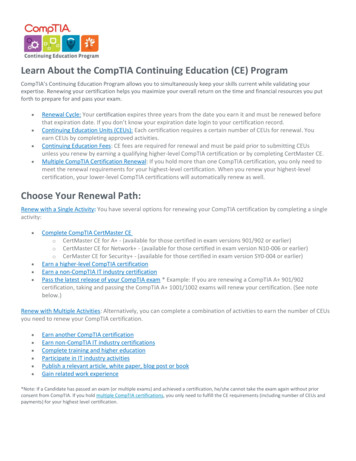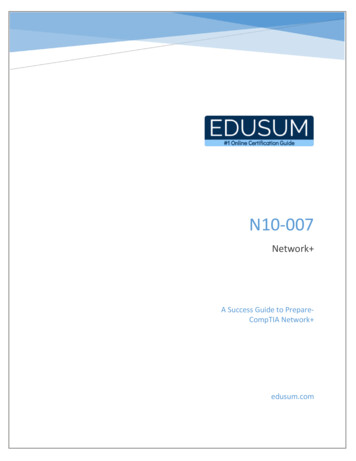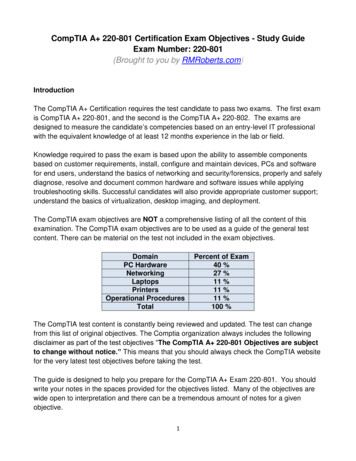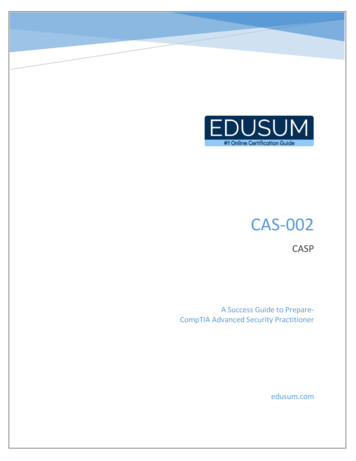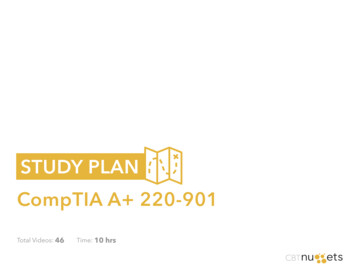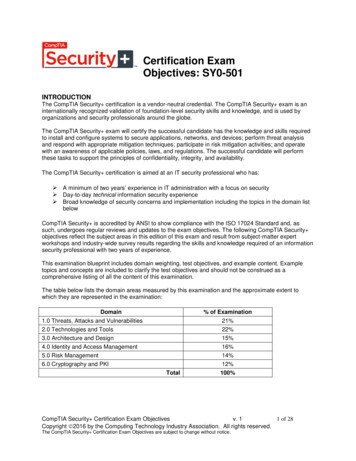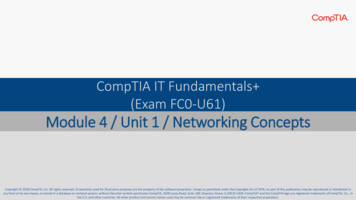
Transcription
CompTIA IT Fundamentals (Exam FC0-U61)Module 4 / Unit 1 / Networking ConceptsCopyright 2018 CompTIA, Inc. All rights reserved. Screenshots used for illustrative purposes are the property of the software proprietor. Except as permitted under the Copyright Act of 1976, no part of this publication may be reproduced or distributed inany form or by any means, or stored in a database or retrieval system, without the prior written permission CompTIA, 3500 Lacey Road, Suite 100, Downers Grove, IL 60515-5439. CompTIA and the CompTIA logo are registered trademarks of CompTIA, Inc., inthe U.S. and other countries. All other product and service names used may be common law or registered trademarks of their respective proprietors.
CompTIA IT Fundamentals 2
Network Components Clients and servers Local Area Network(LAN) Wide Area Network(WAN)CompTIA IT Fundamentals 3
Network Media Nodes/hosts Wired data connectionsoooCopper cablingFiber optic cablingEthernet Wireless (Wi-Fi) data connections WAN linksooooFiber optic cablingPoint-to-point radioCellular radioSatelliteCompTIA IT Fundamentals 4
What is a WAN?A Wide Area Network (WAN) connects sites indifferent geographic locations. WANs usuallymake use of telecommunications and serviceprovider networks rather than being directlyoperated by the network administrators.CompTIA IT Fundamentals 5
Addressing and Protocols Standards and protocols provideso Formatfor computers to exchange data over the network (framesand packets)o Addresses to identify interfaces Network frames and packets have headers and payload Network media standards include Ethernet (cabled links)and Wi-Fi Most local networks and the internet use TCP/IP and IPaddressingCompTIA IT Fundamentals 6
TCP/IP and Packet Transmission Transmission ControlProtocol/Internet Protocol(TCP/IP) Packet transmission versus circuitbased networksCommunications broken into smallpacketso Multiple paths between networknodeso Routers choose best available patho Lost or damaged packets can be resentoCompTIA IT Fundamentals 7
What is a packet made up of?A packet consists of a number offields contained within a headersection plus a payload. The payloadcould be a packet from the protocollayer above.CompTIA IT Fundamentals 8
What are the key features of a packet switching network?Nodes within the network can perform a forwardingfunction, allowing a packet to utilize any available paththrough the network. This makes the network robust againstlink failures. If is beneficial for the network to use smallpackets that are easy to re-send.CompTIA IT Fundamentals 9
TCP/IP Protocol Suite Layers (1)CompTIA IT Fundamentals 10
TCP/IP Protocol Suite Layers (2) Link or Network Interface layeroEthernet/Wi-FioLocal network segment onlyoFrames Internet layeroInternet Protocol (IP)—the main protocol in the TCP/IP suite is responsible for logical addressing and routing of packetsbetween hosts and networks.oAddress Resolution Protocol (ARP)—used for hardware address resolutionoInternet Control Message Protocol (ICMP)—sends messages and reports on errors regarding packet delivery. Transport layeroTransport Control Protocol (TCP) provides connection-oriented deliveryoUser Datagram Protocol (UDP) provides connectionless delivery Application layerCompTIA IT Fundamentals 11
Internet Protocol (IP)FieldSource IP addressDestination IP addressProtocolChecksumTime to LiveCompTIA IT Fundamentals ExplanationIdentifies the sender of the datagram by IPaddress.Identifies the destination of the datagram by IPaddress.Indicates whether the data should be passed toUDP or TCP at the destination host.Verifies the packet's integrity upon arrival at thedestination.The number of seconds a datagram is allowed tostay on the network before being discarded,otherwise packets could endlessly loop aroundan internet. A router will decrease the TTL by atleast one second when it handles the packet, andis required to decrement the TTL by at least thetime spent in the router.12
IP Addresses 32-bit binary value expressed in dotted decimal172.30.15.12 IPv4 versus IPv6 (128-bit *12*01*0128 0 32 0 8 4 0 0 172CompTIA IT Fundamentals 13
What protocol is usually used to providelogical addressing on networks?Internet Protocol (IP)CompTIA IT Fundamentals
Network Prefixes and Subnet Masks IP address contains network ID and host addresso Network ID—commonto all hosts on the same IP networko Host ID—identifies a host on a particular network or logicalsubnetwork Network prefix/subnet mask is used to identifynetwork portion within the IP address Mask shows how many bits from the start of theaddress belong to the network IDCompTIA IT Fundamentals 15
Packet Delivery and Forwarding Logical addressing (IP) versus local/hardwareinterface addressing MAC Addresseso48-bit expressed in hexo00:60:8c:12:3a:bc Address Resolution Protocol (ARP)oIdentifies the MAC address associated with an IPaddress RoutingoIf the network ID of the destination IP address isdifferent to the source, the packet is sent to a routeron the local segment (default gateway)oRouter forwards packet to its destination, possiblyvia intermediate routersCompTIA IT Fundamentals 16
What type of address identifies a networkinterface in the context of the local networksegment only?A Media Access Control (MAC) addressCompTIA IT Fundamentals 17
What type of device is used totransfer packets betweendifferent networks?A routerCompTIA IT Fundamentals 18
Domain Name System (DNS) IP and MAC addresses are very hard to remember Simple names are much easier for people to use Domain Name System (DNS) maps names to IPaddresses Hierarchical, distributed database Root namespace Top Level Domains (TLD)o.com, .edu, .org, .gov, .ca, .uk, . Register domains within a TLD Create hosts and subdomains within a domainnameCompTIA IT Fundamentals 19
Hostnames and Fully Qualified Domain Names Hostname allocated to hostso Upto 256 alphanumeric characters and hypheno Usuallymuch shorter Hostname Domain Name TLD Suffix FullyQualified Domain Name (FQDN)CompTIA IT Fundamentals 20
DNS Query ExampleCompTIA IT Fundamentals 21
Which protocol allows people to usenames/labels to address network resourcesrather than numeric addresses?Domain Name System (DNS)CompTIA IT Fundamentals 22
Uniform Resource Locators (URL) ProtocolAccess method/service typeo Followed by the characters ://o Host locationoIP address or (more typically) FQDN File pathDirectory and file name location of the resourceo Delimited by forward slashoCompTIA IT Fundamentals 23
Which of the following parts of a web address is usuallydepends on a name resolution service: protocol type, hostlocation, file path?The host location is usually represented by a FullyQualified Domain Name (FQDN), such aswww.comptia.org, resolved to a numeric IP address byDNS.CompTIA IT Fundamentals 24
Internet Application Services Internet (IP) andtransport layer (TCP/UDP)responsible foraddressing andestablishing connections Application layerprotocols provide “userlevel” servicesCompTIA IT Fundamentals 25
HTTP and HTML HyperText Transfer Protocol (HTTP) Basis of the World Wide Web Enables clients (typically web browsers) to requestresources from an HTTP server Web servers, intranets, and extranets HyperText Markup Language (HTML) pagesCompTIA IT Fundamentals 26
What does HTTP stand for?HyperText Transfer Protocol(HTTP).CompTIA IT Fundamentals 27
SSL/TLS Secure Sockets Layer (SSL)/Transport Layer Security (TLS) Establishes identity of website and protects communication between server andclient using encryption Site presents a digital certificate issued to it by a Certificate Authority (CA) Client can choose to trust the certificate and CACompTIA IT Fundamentals 28
Electronic Mail (Email) Text messages and binaryattachments—MultipurposeInternet Mail Extensions (MIME) Sending mailSimple Mail Transfer Protocol (SMTP)o MX (Mail Exchanger)o Retrieving messages from amailboxPost Office Protocol v3 (POP3)o Internet Message Access Protocol(IMAP)oCompTIA IT Fundamentals 29
Configuring EmailCompTIA IT Fundamentals 30
Which email protocol(s) are used to download messagesfrom a mail server?Either Post Office Protocol (POP) or Internet MessageAccess Protocol (IMAP).CompTIA IT Fundamentals 31
ReviewImage by Wavebreak Media 123rf.com Describe the components andfunctions of computernetworks List the protocols andtechnologies used foraddressing on computernetworks Connect a computer to a wiredor wireless network Describe the uses of commonapplication protocolsCompTIA IT Fundamentals 32
Module 4 / Unit 1 / Networking Concepts CompTIA IT Fundamentals (Exam FC0-U61) CompTIA IT Fundamentals 2. Network Components Clients and servers Local Area Network (LAN) Wide Area Network (WAN) CompTIA IT Fundamentals 3 Nodes/hosts Wired data connections o Copper cabl
